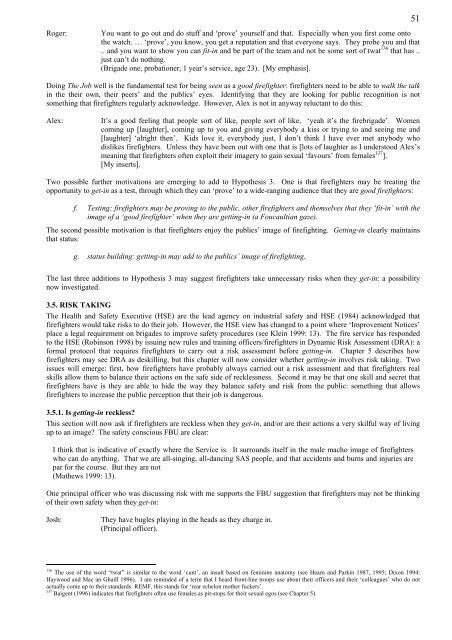One more last working class hero
One more last working class hero
One more last working class hero
Create successful ePaper yourself
Turn your PDF publications into a flip-book with our unique Google optimized e-Paper software.
Roger:<br />
You want to go out and do stuff and ‘prove’ yourself and that. Especially when you first come onto<br />
the watch. … ‘prove’, you know, you get a reputation and that everyone says. They probe you and that<br />
.. and you want to show you can fit-in and be part of the team and not be some sort of twat 136 that has ..<br />
just can’t do nothing.<br />
(Brigade one, probationer, 1 year’s service, age 23). [My emphasis].<br />
51<br />
Doing The Job well is the fundamental test for being seen as a good firefighter: firefighters need to be able to walk the talk<br />
in the their own, their peers’ and the publics’ eyes. Identifying that they are looking for public recognition is not<br />
something that firefighters regularly acknowledge. However, Alex is not in anyway reluctant to do this:<br />
Alex:<br />
It’s a good feeling that people sort of like, people sort of like, ‘yeah it’s the firebrigade’. Women<br />
coming up [laughter], coming up to you and giving everybody a kiss or trying to and seeing me and<br />
[laughter] ‘alright then’. Kids love it, everybody just, I don’t think I have ever met anybody who<br />
dislikes firefighters. Unless they have been out with one that is [lots of laughter as I understood Alex’s<br />
meaning that firefighters often exploit their imagery to gain sexual ‘favours’ from females 137 ].<br />
[My inserts].<br />
Two possible further motivations are emerging to add to Hypothesis 3. <strong>One</strong> is that firefighters may be treating the<br />
opportunity to get-in as a test, through which they can ‘prove’ to a wide-ranging audience that they are good firefighters:<br />
f. Testing: firefighters may be proving to the public, other firefighters and themselves that they ‘fit-in’ with the<br />
image of a ‘good firefighter’ when they are getting-in (a Foucaultian gaze).<br />
The second possible motivation is that firefighters enjoy the publics’ image of firefighting. Getting-in clearly maintains<br />
that status:<br />
g. status building: getting-in may add to the publics’ image of firefighting.<br />
The <strong>last</strong> three additions to Hypothesis 3 may suggest firefighters take unnecessary risks when they get-in: a possibility<br />
now investigated.<br />
3.5. RISK TAKING<br />
The Health and Safety Executive (HSE) are the lead agency on industrial safety and HSE (1984) acknowledged that<br />
firefighters would take risks to do their job. However, the HSE view has changed to a point where ‘Improvement Notices’<br />
place a legal requirement on brigades to improve safety procedures (see Klein 1999: 13). The fire service has responded<br />
to the HSE (Robinson 1998) by issuing new rules and training officers/firefighters in Dynamic Risk Assessment (DRA): a<br />
formal protocol that requires firefighters to carry out a risk assessment before getting-in. Chapter 5 describes how<br />
firefighters may see DRA as deskilling, but this chapter will now consider whether getting-in involves risk taking. Two<br />
issues will emerge: first, how firefighters have probably always carried out a risk assessment and that firefighters real<br />
skills allow them to balance their actions on the safe side of recklessness. Second it may be that one skill and secret that<br />
firefighters have is they are able to hide the way they balance safety and risk from the public: something that allows<br />
firefighters to increase the public perception that their job is dangerous.<br />
3.5.1. Is getting-in reckless?<br />
This section will now ask if firefighters are reckless when they get-in, and/or are their actions a very skilful way of living<br />
up to an image? The safety conscious FBU are clear:<br />
I think that is indicative of exactly where the Service is. It surrounds itself in the male macho image of firefighters<br />
who can do anything. That we are all-singing, all-dancing SAS people, and that accidents and burns and injuries are<br />
par for the course. But they are not<br />
(Mathews 1999: 13).<br />
<strong>One</strong> principal officer who was discussing risk with me supports the FBU suggestion that firefighters may not be thinking<br />
of their own safety when they get-in:<br />
Josh:<br />
They have bugles playing in the heads as they charge in.<br />
(Principal officer).<br />
136 The use of the word “twat” is similar to the word ‘cunt’, an insult based on feminine anatomy (see Hearn and Parkin 1987, 1995; Dixon 1994;<br />
Haywood and Mac an Ghaill 1996). I am reminded of a term that I heard front-line troops use about their officers and their ‘colleagues’ who do not<br />
actually come up to their standards: REMF, this stands for ‘rear echelon mother fuckers’.<br />
137 Baigent (1996) indicates that firefighters often use females as pit-stops for their sexual egos (see Chapter 5).
















